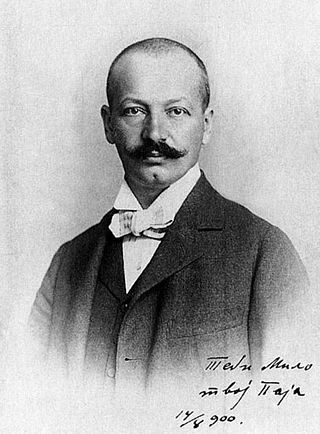
Pavle "Paja" Jovanović was a Serbian realist painter who painted more than 1,100 works including: The Wounded Montenegrin (1882), Decorating of the Bride (1886), The Takovo Uprising (1894), Migration of the Serbs (1896) and The Proclamation of Dušan's Law Codex (1900). As one of the best European painters of oriental scenes, Paja at the end of the 19th century turned to painting historical events of Serbian history. Paja was also the premier portraitist of Europe after 1905. He painted the Emperor Franz Joseph I of Austria 15 times, he painted royalty, major industrialists, scientists, bankers, oil barons and monopolists, including certain heirs to the Standard Oil fortune in the United States of America. He was a very sought-after portraitist world-wide, which made him incredibly wealthy in his lifetime. Many European and international museums carry his works, signed under various names including: Paul Joanowitch in the National Gallery of Victoria and also two portraits in the Utah Museum of Fine Arts, Paul Joanowits, Paul Ivanovitch, Paul Joanovitch, Paul Joanovitsch, P. Joanowitsch and others.
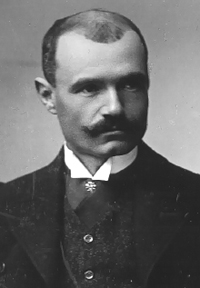
Mihailo Petrović Alas, was a Serbian mathematician and inventor. He was also a distinguished professor at Belgrade University, an academic, fisherman, philosopher, writer, publicist, musician, businessman, traveler and volunteer in the Balkan Wars, the First and Second World Wars. He was a student of Henri Poincaré, Paul Painlevé, Charles Hermite and Émile Picard. Petrović contributed significantly to the study of differential equations and phenomenology, founded engineering mathematics in Serbia, and invented one of the first prototypes of a hydraulic analog computer.

Đorđe Andrejević-Kun was a Serbian painter and academic. He designed the coat of arms of the City of Belgrade and reputedly designed the coat of arms of the Socialist Federal Republic of Yugoslavia and Yugoslav orders and medals.

Dušan Matić was a Serbian poet who was active as part of the Belgrade surrealist group.
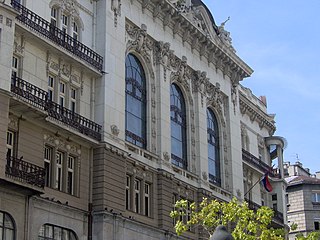
The Serbian Academy of Sciences and Arts is a national academy and the most prominent academic institution in Serbia, founded in 1841 as Society of Serbian Letters.

Stari Grad is a fortress near the city of Užice, in central Serbia. Today in ruins, it is an example of typical medieval Serbian architecture. Historians believe it was built in the second half of the 14th century to control movement along nearby roads, and the town of Užice. Stari Grad was declared Protected Monument of Culture in 1983, and it is protected by Republic of Serbia. Though in ruins, the fortress is considered a symbol of Užice.

Nikola Hajdin was a Serbian construction engineer, professor and the president of the Serbian Academy of Sciences and Arts, as a member of the Department of Technical Sciences.

Jovan Đorđević was a Serbian writer, dramatist, Minister of Education and the co-founder of the Novi Sad Serbian National Theatre in 1861, the National Theatre in Belgrade in 1868 and the Academy of Dramatic Art in 1870. He is most famous for writing the lyrics to the Serbian National anthem Bože pravde in 1872. He was also a member of Matica Srpska.

The New Cemetery is a cemetery complex in Belgrade, Serbia, with a distinct history. It is located in Ruzveltova street in Zvezdara municipality. The cemetery was built in 1886 as the third Christian cemetery in Belgrade and as the first architecturally and urbanistically planned cemetery in Serbia.

Architecture of Belgrade is the architecture and styles developed in Belgrade, Serbia. Belgrade has wildly varying architecture, from the centre of Zemun, typical of a Central European town, to the more modern architecture and spacious layout of New Belgrade. The oldest architecture is found in Kalemegdan park. Outside of Kalemegdan, the oldest buildings date only from 19th century, due to its geographic position and frequent wars and destructions. The oldest public structure in Belgrade is a nondescript Turkish türbe, while the oldest house is a modest clay house on Dorcol, the House at 10 Cara Dušana Street from 1727.
Milorad Bata Mihailović was a Serbian painter.
Miladin Zarić (1889–1976) was Serbian and later, Yugoslavian teacher. At the end of World War II and liberation of Belgrade, the capital of Yugoslavia on 20 October 1944, during their retreat, the Nazis have mined the Old Sava Bridge, in order to stop the progress of the Soviet Red Army and the People's Liberation Army of Yugoslavia that were chasing them. They would have got away with it if there was not Miladin Zarić, a school teacher and a plain civilian with a considerable experience in demining gained previously during Balkan Wars and First World War. He saved the bridge from demolition, by cutting the detonator wires, making it the only large bridge in Europe, beside Ludendorff Bridge that the Germans didn't succeed in demolishing while retreating. The importance of his act is even bigger considering that the next bridge connecting Belgrade and Syrmia was in Šabac, 90 kilometers away.
Obilićev Venac, a pedestrian and shopping zone, is located in the city center of Belgrade, Serbia, within the Knez Mihailova Street spatial unit protected by law, and contains a number of residential and office buildings dating from 1900 to 2000.

The house of Jevrem Grujić is located in 17 Svetogorska Street, – the first designated heritage building since the founding of the Cultural Heritage Protection Institute of the City of Belgrade, in 1961. It is located in the immediate distance from the theatre "Atelje 212". The descendants of Jevrem Grujić, a prominent figure of the Serbian 19th century diplomacy, still live in this house. The life and work of members and descendants of the Grujić family is associated with the important political and social events in Serbia.

„Cvijeta Zuzorić“ Art Pavilion is an exhibition building in Belgrade, in Kalemegdan, situated in the park's section of Little Kalemegdan, next to the south-eastern front of the Belgrade fortress. It was built between 1927 and 1928 after the design of the architect Branislav Kojić, in the Art Deco architectural style. It was the first venue built specifically as an exhibition space, or an art gallery, in Serbia.

The House of Vuk's Foundation is the name of a historical building in Belgrade, built in 1879, that serves as the headquarters of the Vuk's Foundation. Located on the Теrazije at 2 Kralja Milana Street, it is one of the oldest structures in that part of Belgrade. Aleksandar Bugarski, a prominent 19th-century Serbian architect, designed the original building as a two-story house in the Academic art style of the day.
Vasa Pomorišac was a Serbian artist and professor at the Academy of Applied Arts in Belgrade. He worked as a painter, stained glass window maker, etcher, printmaker and he was also an art critic. He is considered an expressionist painter in the same category as his contemporaries Mihajlo Petrov, Ivan Radović, Petar Dobrović, and Jovan Bijelić.
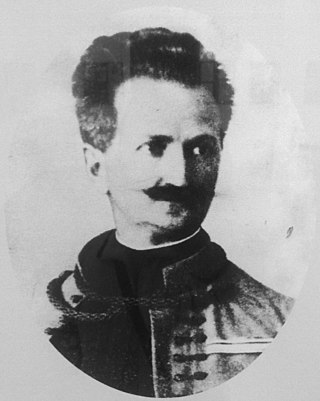
Momir Korunović, was a Serbian architect best-known for his projects built in Serbo-Byzantine Revival. He was sometimes called the Serbian Gaudi. Although he designed some of the most beautiful buildings in Belgrade and was the leading architect of sacred buildings in Yugoslavia between the two world wars, today he is insufficiently known to the general public. Many of his works were destroyed or substantially altered during World War II and the period of communist dictatorship.
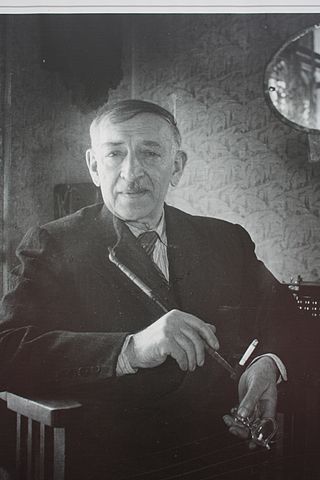
Rista Marjanović, the first Serbian photo-reporter, author of photographs from the Balkan Wars, World War I and World War II.
Lazar Trifunović was a Serbian art historian, art critic and professor at the University of Belgrade.















